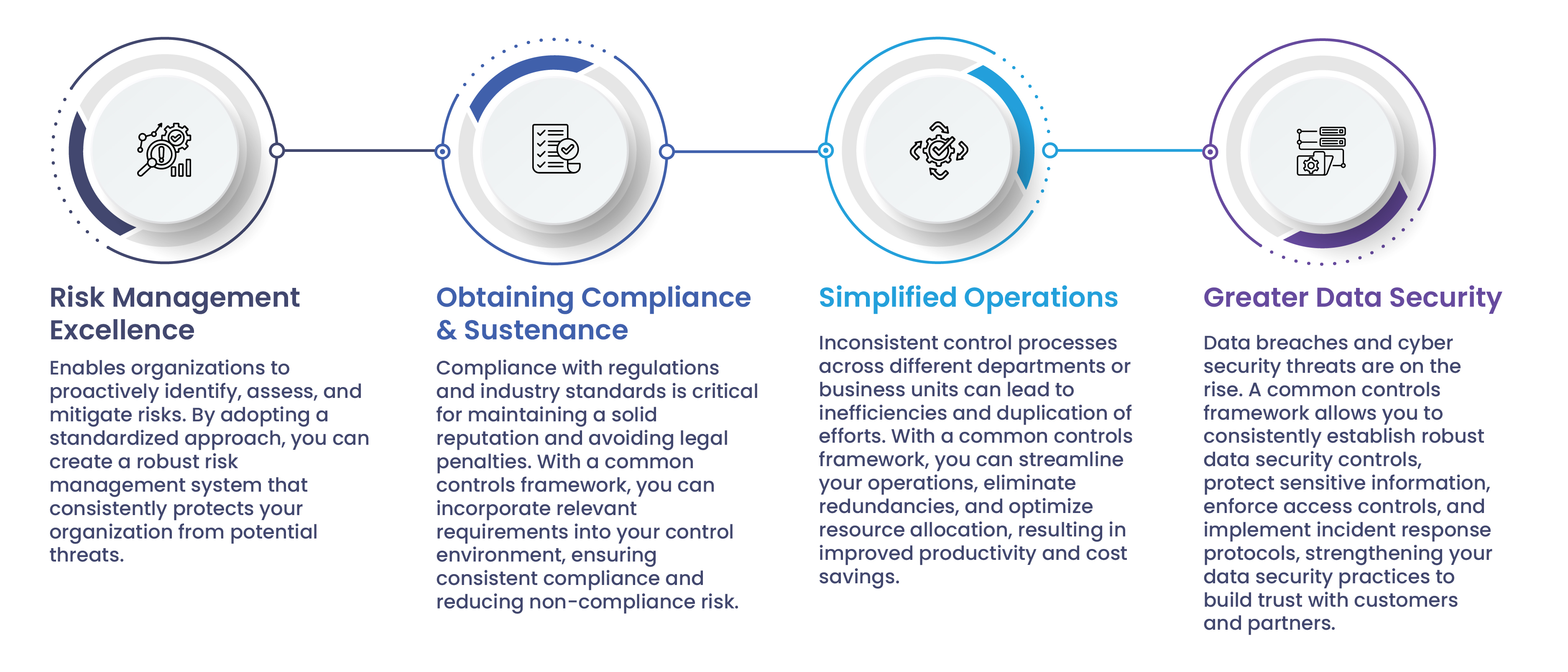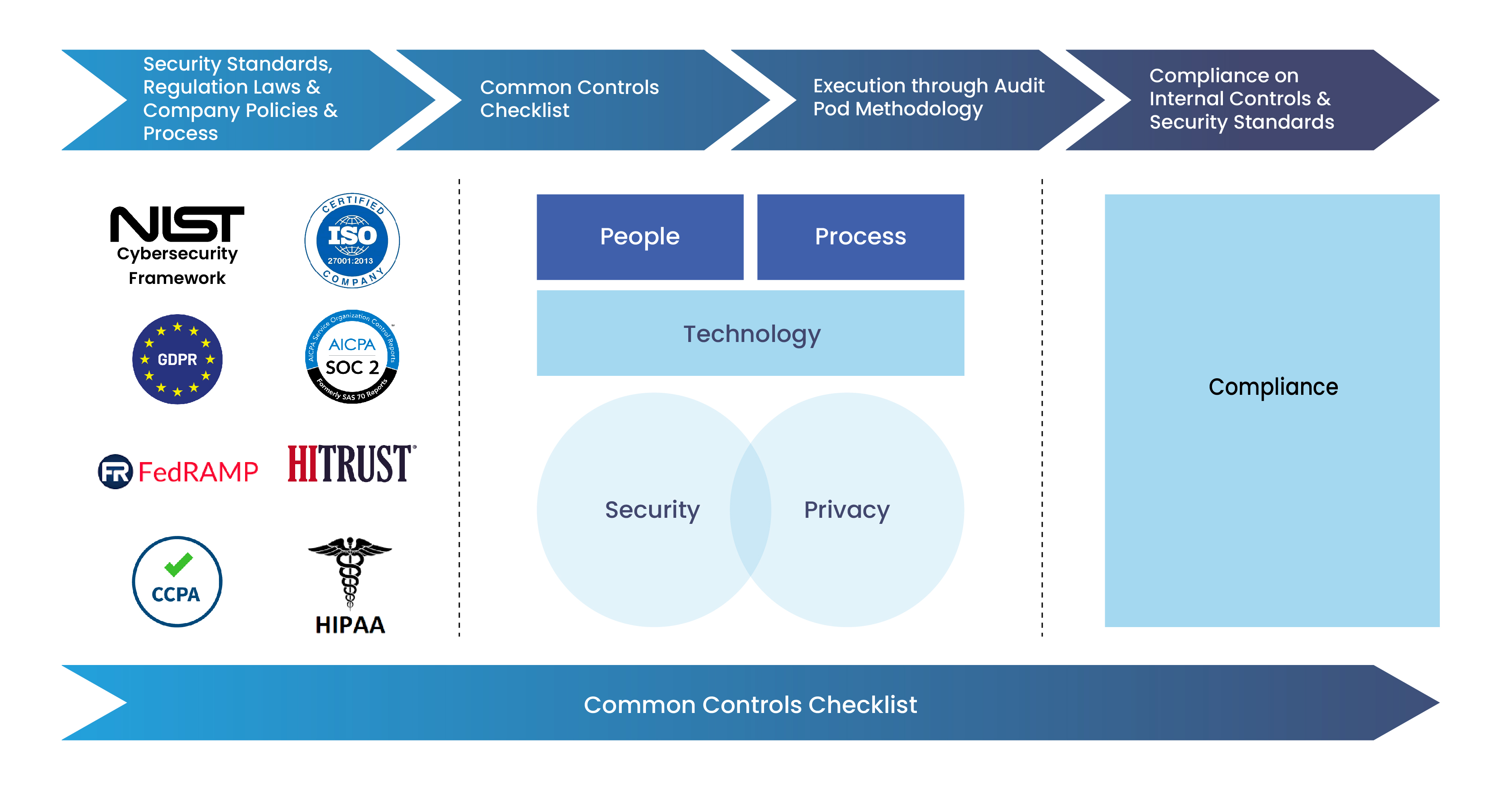
Listen to this blog
Cybersecurity, compliance, and risk management are becoming increasingly complex today. Businesses must navigate a growing number of regulatory requirements and standards, including Sarbanes Oxley (SOX), NIST Cybersecurity Framework (CSF), FedRAMP, HIPAA, the EU's GDPR rules, and many others. With each framework evolving and expanding, enterprises need to stay up-to-date and adopt those that are relevant to their operations.
Common Controls Framework offers a valuable starting point for organizations seeking to enhance compliance with diverse cybersecurity and privacy frameworks. By embracing these frameworks, organizations can navigate the complexities of regulatory landscapes and strengthen their cybersecurity and risk management practices effectively.
What is a Common Controls Framework?
In general terms, common controls encompass a wide range of security protocols, safety measures, and protective mechanisms that are implemented across an organization. These controls cover various areas, including operations, cybersecurity, privacy, third-party risk, and reputational risk.
A common controls framework (CCF) is a comprehensive roadmap for organizations to establish, implement, and monitor these internal controls. It is a structured approach that aligns with industry best practices and regulatory requirements, providing a standardized set of organizational controls and guidelines.
Objectives of Common Controls Framework:
The Common Controls Framework has several objectives that benefit cyber, audit, and compliance teams. One of its primary purposes is to establish and map standards or regulatory frameworks, such as NIST, HIPAA, ISO 20071, SOC2, PCI DSS, etc., that apply to an organization's security documentation and management system. The framework also helps create control activity descriptions and comprehensive audit plans for each in-scope standard or process. It supports various stakeholders in reducing audit stress and shortening audit response times. Additionally, the framework draws attention to the artifacts that need to be maintained for verification purposes.
Why Choose a Common Controls Framework?
By implementing a Common Controls Framework, organizations can comprehensively understand regulations and standards and their implementation throughout the organization. This not only saves valuable time but also enhances overall efficiency, instilling a sense of peace of mind. Let's explore various ways in which CCF facilitates these benefits:

![]()
Streamline Compliance with Common Controls Framework
Visionet specializes in helping organizations implement a common controls framework that ensures consistency, compliance, and operational excellence. Having an in-depth understanding of all regulatory standards, our seasoned Governance, Risk, and Compliance (GRC) professionals meticulously customize a CCF to meet your business’s unique needs while keeping industry dynamics into consideration.
Our Common Controls Framework Approach

Visionet’s Common Controls Framework Consulting Services:
Our comprehensive CCF consulting services include:
- CCF Development and Design: We assess your current control, identify gaps, and tailor the framework to address your risks and compliance needs.
- Control Mapping and Gap Analysis: Our experts identify control gaps, weaknesses, and inefficiencies, providing you with a comprehensive gap analysis report.
- Risk Assessment and Management: Our experts help you identify and prioritize potential risks and establish risk mitigation strategies and control activities to effectively address these risks.
- Policy and Procedure Development: We collaborate with key stakeholders to establish clear control objectives, define control activities, and create documentation that supports your compliance efforts.
- Training and Awareness Programs: Our tailored training sessions educate your employees on the importance of controls, their responsibilities in maintaining an effective control environment, and the impact of regulatory compliance on business operations.
- Control Testing and Assurance: We perform control walkthroughs, testing of key controls, and control self-assessments to provide you with assurance over the reliability and effectiveness of your control environment. Our recommendations help you enhance control performance and meet regulatory requirements.
- Compliance Monitoring and Reporting: We help you design control monitoring mechanisms, implement control testing programs, and develop reporting frameworks to ensure ongoing compliance.
- Continuous Improvement and Optimization: Our experts help you establish a feedback loop for capturing control deficiencies, monitoring changes in regulatory requirements, and updating your framework accordingly.
Summing Up
Common Controls Frameworks serve as a beneficial starting point for organizations aiming to enhance their compliance with diverse cybersecurity and privacy frameworks. By adopting these frameworks, organizations can effectively navigate the complex regulatory landscapes and bolster their cybersecurity and risk management practices.
This proactive approach enables organizations to lay a solid foundation for compliance, ensuring they are well-prepared to address the challenges posed by different frameworks and strengthen their overall security posture.
Way Forward
With Visionet, you can enforce a preventative approach to risk management, compliance, and operational efficacy. Learn how we can help you strengthen your organization's control environment, mitigate risks, and ensure long-term success. Schedule a consultation now!




